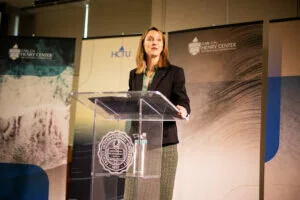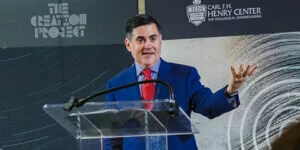A modern maxim has long since taken up residence in most theology departments across the world today: we no longer live in a time where the old, substantival metaphysics remain convincing.
If historical-theological accounts of the nineteenth century have taught us anything, it was that each passing theologian sought to outdo the one who had come before by severing the tie of so-called “speculative metaphysics” from theology in order to save it from becoming a purely academic discipline foreign to the community at large. But has the theology produced under such a maxim truly served the community?
This is a story we cannot traverse here, save from one angle—the relationship between the loss of the scaffolding of substantival metaphysics and what it means to be human.
The Human Soul: Incorporeal & Subsistent
According to Mary L. VandenBerg, associate academic dean and professor of systematic theology at Calvin Theological Seminary, it’s precisely a substantialist understanding of the image of God that needs to be retrieved—for the sake of humanity itself.
What does it mean to made in God’s image? The tradition, says VandenBerg, was not considering this in terms of physical capacityThis older notion and the metaphysics it relied on seemed to answer some of the questions about how persons who lack certain capacities physically could still be considered human. (which we take for granted today)—a brain—but in terms of a metaphysical capacity that would be associated with an immaterial soul.
“I started reading more about this older notion and the metaphysics it relied on and it seemed to answer at least some of my questions about how persons who lack certain capacities physically could still be considered human,” VandenBerg says. “Because I have also been unsatisfied with modern relational views that seem to me to do all sorts of gymnastics to get around the lack of relational ability in those with severe intellectual disabilities, this seemed like a potentially plausible answer.”
And this was enough to pique her interest in the older metaphysics—despite the disdain aimed at it among many theologians today.
VandenBerg notes that traditionally the soul was identified primarily with the intellect and reason, with variations on that theme down through the centuries. Still, “the tradition as a whole generally understood the image of God as seated in the soul and associated with the capacity for reason.”
The Modern Displacement of the Soul
This traditional understanding remained dominant until relatively recently, according to VandenBerg, and “over the past several decades, relational descriptions of the image of God have gradually replaced essentialist understandings,” she says, which “was due in part to wide-ranging critiques from a variety of fields, including science, philosophy, feminist and gender studies, and most recently disability studies.”
In short, the existence of a soul has been deemed no longer necessary. The findings of neuroscience suggest that “as the person develops, a soul (or mind) emerges but not as a separate substance of some sort.” Neurochemical phenomenon purportedly now give full account for any soul-like behaviors. When theologians follow suit, argues VandenBerg, eschewing any talk at all of the idea of a soul in theological discourse is tantamount to eliminating from those discussions the very idea of the image of God.
For others, the concern has been the applicability of God’s image to all human persons.
“For example, in the ancient world women were assumed to be deficient in the ability to reason. As a result,Could a retrieval of a historical anthropology that associates the image of God with the metaphysical reality of a soul offer a more robust understanding of what make all humans unique from other creatures, including ancient hominids? women could easily be construed as not being fully the image of God and therefore not fully human,” says VandenBerg.
Women are one group among many, of course, that have suffered from dehumanizing theological impositions such as this.
“A similar but more recent concern is that narrowly identifying the image in terms of intellect and reason leaves any number of people with diminished intellectual capacities on the sidelines of what can be considered fully human since many persons with profound intellectual disabilities do not have the ability to reason.”
VandenBerg thinks that relational anthropologies have allowed theologians to “circumvent the scientific challenge to the traditional conjoining of the soul with the image of God.” But they have also offered helpful theological and experiential corrections to more traditional formulations that have emphasized the capacity for reason “at the expense, at times, of other features of the image of God.”
In response to these issues, VandenBerg’s proposed research question for The Creation Project during the fall 2018 semester will be as follows: “Could a retrieval of a historical anthropology that associates the image of God with the metaphysical reality of a soul offer a more robust understanding of what make all humans unique from other creatures, including ancient hominids?”
She goes on: “My own sense is that disconnecting the image of God from notions of a substantial soul along with defining capacities merely in physical terms has left a void with respect not only to understanding humans as unique beings, but also to offering a strong basis for understanding all humans, including those at the edges of life, as fully human.”
To do so, VandenBerg intends to begin her project by examining the biblical concept of the image of God in order to lay a clear biblical foundation for her subsequent work. From there, she plans to examine more deeply the objections to a substantialist understanding of the image and see if there are plausible replies to those objections from the tradition.
“I think that many of the objections stem from a misunderstanding of the tradition, based on what I have read so far,” she says. “If this is the case and I am able to answer the objections, I think an integrated biblical-theological framework of understanding the image of God will offer a way forward for thinking about humans as unique beings created to glorify and enjoy God.”
Science & the Bible: Relationship Status—It’s Complicated
Part and parcel of that glorifying and enjoying God, according to VandenBerg, is the human penchant for curiosity—to seek out the truth wherever it may lead, even if to inarticulable mystery. Instead of contradictory or even complementary models of where and how scripture and science meet, she stops short of over-defining their relationship.
Scripture, she says, is not a science text and science is not revelatory in the same sense that Scripture is not a science text, and science is not revelatory in the same sense that Scripture is.Scripture is. Rather, science (and creation in general) leads us to ponder God’s power and divinity—enough, in fact to leave us without excuse, but never fully revealing the Triune God and his relationship with the world.
“On the level of knowledge of God, I think scripture and creation will not contradict, although humans will inevitably distort the knowledge of God apart from scripture (Rom. 1). On the level of knowledge of creation, science is dealing with small ‘t’ truth and scripture is not ultimately concerned with the questions of science. So it seems there could be contradiction on this level.”
Accordingly, VandenBerg notes that there are two errors people tend to fall into: (1) The Bible said it; I believe it; that’s the end of it. (2) Science said it; I believe it; that’s the end of it.
“Both science and scripture can have their own variety of fundamentalism,” she cautions.
Ultimately, on this score, VandenBerg wants to encourage Christians to be curious, to not be afraid of science and its fascinating findings about the created world. Scripture, of course, provides an equally fascinating—though inspired—narrative of the world.
“When it feels like they are contradicting,” VandenBerg says, “consider living with the tension rather than either eliminating one because of the other, or trying to reconcile them. The beauty may very well be in the mystery, just as it is with God.”
2018–19 Henry Resident Fellows
2018–19 Henry Fellows Announced | Learn More
James Hoffmeier, “Why We Believe in Creation & Evolution: A Discussion between an Evolutionary Biologist & an Old Testament Scholar” | Learn More
Fred Sanders, “The Doctrine of Humanity in Systematic Perspective” | Learn More
Dru Johnson, “Man Made: If Biblical Texts Could Speak to Modern Origins Stories” | Learn More
Ryan Peterson, “Human Identity in Theological Anthropology” | Learn More
Mary VandenBerg, “Retrieving a Substantialist Understanding of the Image of God”
Ralph Stearley, “Assessing Evidences for Cognitive Capacities in Ancient Hominins, with Reference to their Perception of God” | Learn More
Joshua Farris, “The Soul of Science and Religion: Theological Anthropology, Substance Dualism, and Origins” | Learn More







Comments
Be the first one to make a comment!